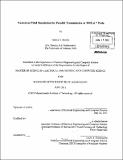Numerical field simulation for parallel transmission in MRI at 7 tesla
Author(s)
Bernier, Jessica A. (Jessica Ashley)
DownloadFull printable version (2.606Mb)
Other Contributors
Massachusetts Institute of Technology. Dept. of Electrical Engineering and Computer Science.
Advisor
Elfar Adalsteinsson.
Terms of use
Metadata
Show full item recordAbstract
Parallel transmission (pTx) is a promising improvement to coil design that has been demonstrated to mitigate B1* inhomogeneity, manifest as center brightening, for high-field magnetic resonance imaging (MRI). Parallel transmission achieves spatially-tailored pulses through multiple radiofrequency (RF) excitation coils that can be activated independently. In this work, simulations of magnetic fields in numerical phantoms using an FDTD solver are used to estimate the excitation profiles for an 8-channel RF head coil. Each channel is driven individually in the presence of a dielectric load, and the excitation profiles for all channels are combined post-processing into a B1+ profile of the birdcage (BC) mode. The B1 profile is calculated for a dielectric sphere phantom with material properties of white matter at main magnetic field strengths of 3T and 7T to demonstrate center brightening associated with head imaging at high magnetic field strengths. Measurements of a circular ROI centered in the image show more B1+ inhomogeneity at 7T than at 3T. The B1* profile is then simulated for a numerical head phantom with spatially segmented tissue compartments at 7T. Comparison of the simulated and in vivo B1* profiles at 7T shows agreement in the B1 inhomogeneity. The results provide confidence in numerical simulation as a means to estimate magnetic fields for human imaging. This work will allow further numerical simulations to model the propagation of electric fields within the body, ultimately to provide an estimate of heat deposition in tissue, quantified by the specific absorption rate (SAR), which is a limiting factor of the use of high-field MRI in the clinical setting.
Description
Thesis (S.M.)--Massachusetts Institute of Technology, Dept. of Electrical Engineering and Computer Science, 2011. Cataloged from PDF version of thesis. Includes bibliographical references (p. 41-42).
Date issued
2011Department
Massachusetts Institute of Technology. Department of Electrical Engineering and Computer SciencePublisher
Massachusetts Institute of Technology
Keywords
Electrical Engineering and Computer Science.